Harvard Researchers Create Nanoscale Lasers
Published on Wed Oct 18 2023 Green laser VS small tree | Helmuts Rudzītis on Flickr
Green laser VS small tree | Helmuts Rudzītis on FlickrAccording to a new preprint paper, scientists at Harvard have made a new discovery in the world of nanophotonics - successfully achieving laser emission in single nanoparticles. This achievement has significant implications for a wide range of applications, from physical sciences to biomedical research.
In a preprint paper, researchers revealed that they were able to exploit metallic plasmons, specifically localized surface plasmons (LSP), to create nanoscale lasers. Plasmons are tiny particles that oscillate when excited by light, enabling the conversion of light into energy. While previous studies focused on nano-lasers utilizing surface plasmon polaritons (SPP), achieving LSP lasing in single nanoparticles has long been considered a challenging feat.
The scientists demonstrated the equivalence between LSP and SPP within resonant systems and successfully realized a diffraction-limited dipolar emitter. By integrating plasmonic oscillation in gold with dielectric resonance in high-gain III-V semiconductors, they achieved single-mode stimulated emission with impressive linewidth Q factors over 50 at room temperature. The lasers' wavelength tunability ranged from 1190 nm to 1460 nm, determined by the size of the resonator.
What makes this research particularly exciting is the potential it holds for biological applications. The study revealed that higher-order, isolated laser particles within live biological cells reached linewidth Q values surpassing 250. This opens up new possibilities for multiplexed biological applications, such as precise imaging and manipulation of cellular processes.
The achievement of laser emission in single nanoparticles has fundamental implications for nanophotonics. By reaching sub-wavelength laser oscillation, researchers have expanded our understanding of resonant structures and their behavior in three dimensions. Additionally, the study provides valuable insights into the temporal and spectral dynamics of semiconductor lasers under optical pumping.
While there is still much work to be done, this research represents a significant breakthrough in the field. The ability to produce lasers in single nanoparticles has the potential to revolutionize various industries, from medicine to telecommunications. As scientists delve deeper into the possibilities offered by nanophotonics, we can expect exciting developments that will further shape the future of technology and innovation.



